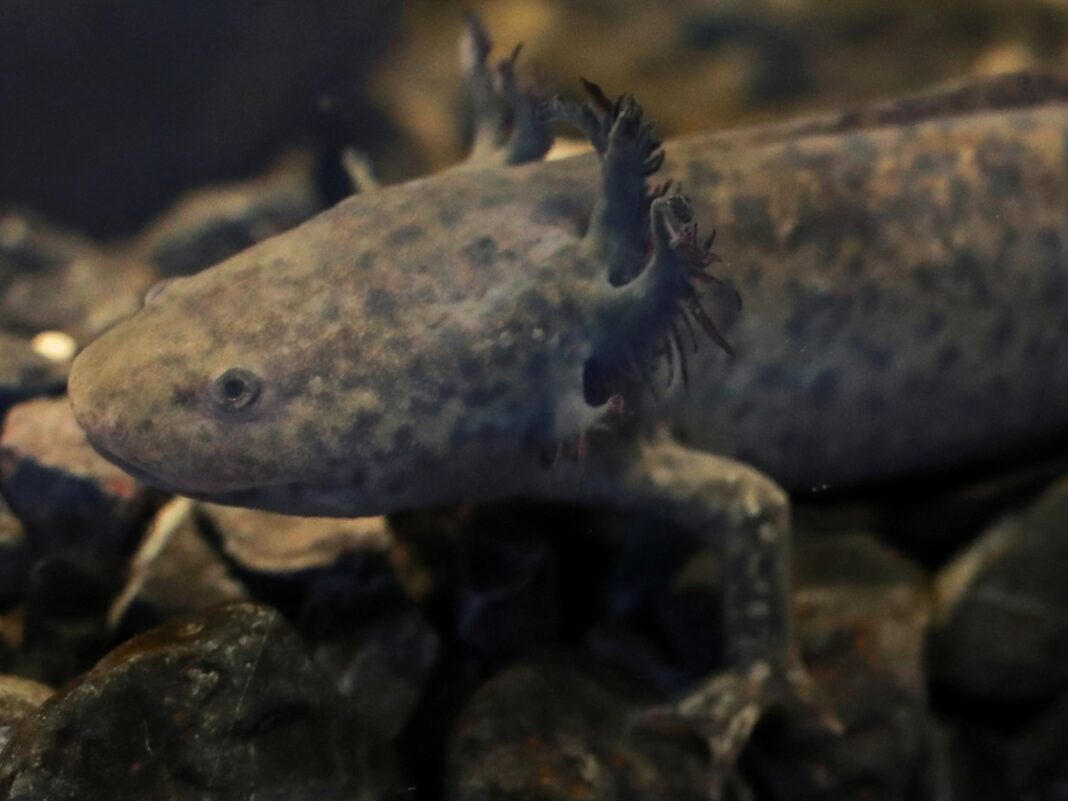One of the world’s most endangered amphibians – the primordial and fish-like axolotl – has successfully adapted to a new environment after being released into artificial wetlands in Mexico, scientists say.
In a study that provides hope for the survival of the Ambystoma mexicanuma, a creature that has been pushed to the brink of extinction by pollution and human activity, scientists recently released 18 captive-bred axolotls into two artificial wetlands close to Mexico City.
Researchers fitted the smiley-face amphibians with trackers and found they were feeding at both sites. Lead researcher Alejandra Ramos from the Autonomous University of Baja California told the BBC it was an “amazing result”.
The findings were published in the journal PLoS One and suggest the axolotl can be successfully restored to its native habitat.
What is the axolotl?
Legend has it that the axolotl was not always an amphibian. Long before it became Mexico’s most beloved salamander, it was believed to be the embodiment of the Aztec god of fire and lightning, Xolotl.
While there are no official estimates on its current population, the species – which is endemic to central Mexico – was classed as “critically endangered” by the International Union for Conservation of Nature’s Red List of Threatened Species in 2019.
They breathe through their gills and skin, which allows them to adapt to their aquatic environment. They can also regenerate parts of their heart, spinal cord and brain.
The salamander’s skin is typically dark although an albino variety can be bred. They can stay stock still for hours in their natural habitat, buried in mud to conserve energy and wait for prey.
In their main stronghold, Lake Xochimilco, located in the southern part of Mexico City, axolotl numbers have plummeted by 99.5 percent in less than two decades. In 1998, researchers estimated there were 6,000 axolotls per square kilometre in Lake Xochimilco. By 2014, this number had dropped to just 36.
How at risk is the axolotl?
Mexico is a biodiversity hotspot for amphibians and reptiles owing to its unique and varied habitats from tropical rainforests and deserts to cloud forests and temperate woodlands.
The waters of Xochimilco, once used for traditional farming and flushed with spring water from the mountains, used to teem with large, smiley-faced axolotls.
But pollution from Mexico City’s expanding urban sprawl has damaged the water quality of the city’s canals, which flow into the lakes. Furthermore, rainbow trout, which have escaped from nearby farms, have displaced axolotls in lakes around the capital and eaten their food.
Researchers have also found that increasing numbers of axolotls have died from chytrid fungus, a skin-eating disease causing a catastrophic reduction in amphibian numbers in other parts of the world from Europe to Australia. The fungus has also been found in Mexico although it is not yet a major problem.
Climate change is another factor threatening the axolotl as even small shifts in temperature and rainfall can disrupt ecosystems and erode biodiversity.
In 2013, scientists voiced fears that they might disappear altogether by 2025.
The axolotl isn’t the only species in Mexico facing an uncertain future. The pine forest stream frog, the clarion night snake and the Mexican alligator lizard are some of the other species that are also critically endangered.
How was the conservation effort for axolotls carried out?
To lay the foundations for the rewilding project, researchers meticulously monitored the ecology of the axolotls to establish their ideal living conditions.
Then they worked with local farmers and a team of volunteers to create wetland “refuges”, or artificial wetlands, near Xochimilco by installing natural filtering systems to clean the water.
The scientists then released the amphibians into two types of wetland environments: restored natural wetlands and the artificial wetlands designed specifically for conservation purposes.
These environments differ in their ecological structure, water chemistry and temperatures, variables that are critical determinants of amphibian physiology and behaviour.
The axolotls were tagged with radio tracking devices to keep tabs on the amphibians. One of the key findings from the study was the axolotls’ ability to navigate and inhabit both artificial and restored wetland ecosystems effectively.
While biologists and officials have led efforts to save the species and its habitat from extinction, a parallel, unexpected preservation phenomenon has emerged in recent years as the creature has benefitted from an unexpected resurgence of interest.
The axolotl attracted international attention after the Minecraft computer game added the creature in 2021. That same year, the Bank of Mexico also decided to print an image of the animal on the 50-peso bill.
Axolotls can now be spotted all over Mexico on murals, clothing and as children’s toys. Some bakeries have caused a sensation with their axolotl-shaped cakes and biscuits.
“If we lose this species, we lose part of our Mexican identity,” co-lead researcher Luis Zambrano from the National University of Mexico told the BBC.

Could other amphibians be saved too?
Climate change, habitat loss and outbreaks of disease have taken their toll on amphibians around the world. Half of all amphibian species are in decline while a third are threatened with extinction.
The team overseeing the axolotl study said public funding is key to preventing the loss of other species as well.
Over his six-year term, however, Mexican President Andres Manuel Lopez Obrador, who was in office from 2018 to 2024, reduced funding to the Secretariat of Environment and Natural Resources by 35 percent.
While scientists involved in the project hope to restore the axolotl’s population, they also highlighted the need for government, business and individual engagement.
“Many animals are losing their habitat around the world,” Ramos said. “And restoration projects are not easy, but they can be done. They just need a lot of people.”


